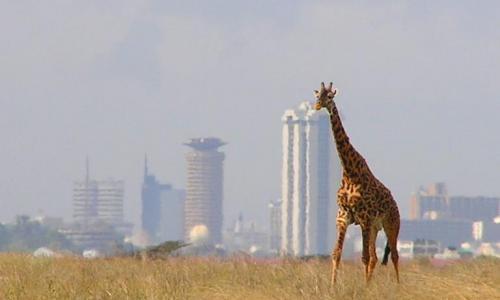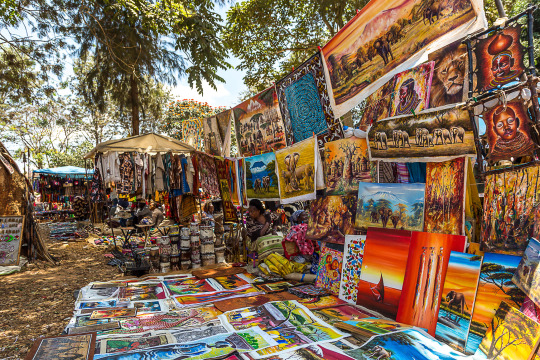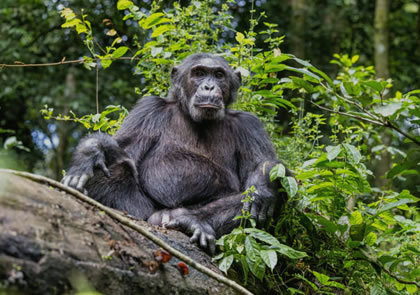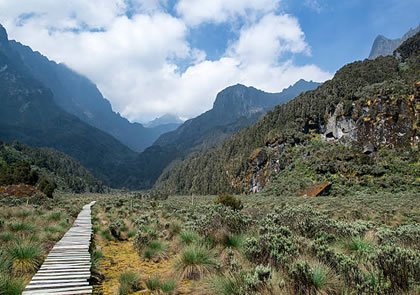#maasai market
Explore tagged Tumblr posts
Text

“If foodstuffs or craft items are to be moved to market, it is the women who carry them in most cases.”
From: “Cultures in Context Series AFRICAN HABITATS : FOREST, GRASSLAND AND SLUM Studies of the Maasai, the Luhya, and Nairobi’s Urban Fringe” by John Tyman
65 notes
·
View notes
Text
In drylands and montane systems, these are often what are called ‘non-equilibrium’ systems, driven by variations in rain or snowfall, rather than the population pressures of animals. When a drought occurs, for example, very often, annual grasses disappear, grazing is short, and animals are lost, but when the rain comes again, the system bounces back, and so do animal populations. Concepts such as carrying capacity and stocking rate control, designed for stable grasslands in more temperate settings, are largely irrelevant in such highly variable environments. The traditional conservationist plea to return to a balance of nature simply does not apply. This makes regulating livestock populations according to fixed numbers for ‘conservation’ purposes inappropriate – as has been imposed on reindeer herders in Norway or Maasai pastoralists in Tanzania.
[...]
Rangelands, where pastoralists make a living, are ‘open ecosystems’, mixes of trees and grasses maintained by a combination of grazing and fire. These are highly dynamic ecosystems – savannas, parklands, montane rangelands, and so on – and are important on all continents. Yet they remain poorly understood as many assume that the ‘climax’ vegetation is always a closed forest. This has led some to argue for the planting of trees in rangelands. The assumption is that these are degraded forests and planting trees can return the landscape to its ‘natural’ state, and in the process, carbon can be sequestered and sold. This is a big mistake, rooted in a poor ecological understanding. What is ’natural’ is, of course, unclear given these areas have been used for millennia. Trees planted in such settings often die and tree planting projects have a dismal track record. Tree planting may not be the best method for sequestering carbon, even if above-ground carbon is easier to sell on offset markets, as grasslands and soils are massively important but poorly understood parts of the carbon cycle.
59 notes
·
View notes
Text


Asia, Africa, India and Latin America
While we have been focusing on North America, the park model was actually exported throughout the world, forcing millions of tribal peoples out of their habitats/territories. The practice continues to this day in Asia, Africa and India, for example, where non-profit foundations and United Nations sponsored organizations are eagerly trying to protect what little land is left that hasn’t been destroyed by industrial modes of living.
Unfortunately, be it the Twa peoples expulsion from Congo’s Kahuzi-Biega National Park, the Maasai from the Amboseli National Park in Kenya or tribal people in southern India forced out of the Indira Gandhi National Park as part of an “eco-development” scheme funded by the Global Environment Facility, parks and conservation lands remain one more force which dispossesses tribal peoples. In Africa alone, one million square kilometers of land has been expropriated for conservation over the past one hundred years. Estimates in India range around three-quarters of a million people pushed off their traditional lands for conservation, in Africa the number is likely in the millions. Unfortunately, and ironically, land that has long been occupied and protected by indigenous peoples continues to be deemed “wild” and therefore suitable for “conservation” primarily by having them declared parks, thus making them out of bounds for the indigenous peoples who maintained them in the first place.
What happens to the people who once lived rich, meaningful lives within these habitats? They become like you and I. Dispossession leads to rootlessness, discouragement, depression, inability to be self-reliant, bad nutrition, broken communities, severed kinship ties, and anger, too often turned inward or directed to the nearest person.
I think we need to realize that dedication to creating parkland and conservation areas does not necessarily coincide with helping regenerate ways of living harmoniously with a habitat. More often than not it promotes a misanthropic outlook that posits intact, healthy land areas being by definition “human-free’’, rather than capitalism-free. We tend to ignore the fact that indigenous peoples seeking to maintain or renew their traditional life ways need to have access tothese areas, especially if the parkland in question was actually part of their traditional territory.
Even liberal organizations like UNESCO have begun to realize that there has been a negative social impact associated with many protected areas. In some places in Asia, Africa and Latin America, provisions have been made for local control so that traditional lifestyles might continue. But these tend to be limited “buffer zones”, where the original inhabitants can control “development projects”. These attempts have not succeeded.
Apparently coalitions of indigenous peoples have had some success in forcing international bodies to recognize their inherent right to manage their traditional territories. “In the 1990s, the World Wildlife Fund for Nature (WWF), the World Conservation Congress and the World Commission on Protected Areas all adopted new policies and resolutions which strongly endorse indigenous peoples’ rights and promote the co-management of protected areas, based on negotiated agreements.[8]” However, these organizations aren’t arguing for free access to one’s habitat, but to “negotiated agreements” with outsiders and centralized authority, and land bases integrated into the scheme of state regulations and subject to the pressures of politics and the market.
Regardless of some recognition, many parks and conservation areas, especially in impoverished countries, remain part of the greater theft of traditional homelands by arrogant, powerful outsiders who impose their views of what constitutes healthy habitats. It isn’t parks and conservation areas that will help stem the tide of destruction and plunder, but recognition that new ways of living are required. And these new ways can be informed by the old ways ofland based people.
#freedom#ecology#climate crisis#anarchism#resistance#community building#practical anarchy#practical anarchism#anarchist society#practical#revolution#daily posts#communism#anti capitalist#anti capitalism#late stage capitalism#organization#grassroots#grass roots#anarchists#libraries#leftism#social issues#economy#economics#climate change#climate#anarchy works#environmentalism#environment
3 notes
·
View notes
Text
’On June 8, 2022, two days after the government announcement, dozens of police, military personnel, and game rangers arrived in Loliondo to demarcate the proposed game reserve. Over several days, the security forces arbitrarily arrested and detained 10 community leaders and fired teargas and rubber bullets at protesters and bystanders, injuring at least 30, including women, children, and older people.
Witnesses said police took from his home an 84-year-old man who has not been seen since. Security forces also destroyed residents’ property and shot and killed livestock. Up to 2,000 residents from various villages across Loliondo fled to seek refuge and medical treatment in neighboring Kenya.
The authorities also arbitrarily arrested and detained a human rights defender and a community member who had shared photos and videos of the violence and its aftermath on social media.
Since then, security forces have continued to commit abuses against Loliondo residents, with victims and witnesses recounting several instances of rape and other sexual violence, nightly raids, and shootings into homes. Residents said game rangers, who are under the authority of the Ministry of Natural Resources and Tourism, have confiscated livestock that had roamed into the demarcated game reserve, initially extorting exorbitant fees to return them and later auctioning them off.
The government contends that blocking access to the area is necessary to protect “the ecological integrity of the entire Great Serengeti,” the area of northern Tanzania involved, and announced that it was “investing in improving pasture grounds, markets for livestock and investment products, plus the provision of drinking water for both people and livestock.” In June 2022, the Natural Resources and Tourism Ministry stated that there are “no settlements” in the area and “therefore there is no eviction.”’
#tanzania#class war#fascism#oppression#repression#Loliondo#ausgov#politas#auspol#tasgov#taspol#australia#fuck neoliberals#neoliberal capitalism#anthony albanese#albanese government#free all oppressed peoples#oppressor#pedagogy of the oppressed#oppressive#eat the rich#eat the fucking rich#anti capitalism#anti colonialism#anti cop#anti colonization#antiauthoritarian#antinazi#antifa#anticapitalista
2 notes
·
View notes
Text
y’all want to hear about one of the most disorienting five seconds of my life?
*sophia from the golden girls voice* so picture this: january of [redacted], it’s my first week in amboseli for my four month field work. we’re still staying at the tourist lodge because my supervisor is still there, getting us settled, and organizing a training course for local academics. meanwhile, we’re doing touristy things until we can start our research.
we’re at a maasai village - a boma - just outside the lodge and park, which is where they take tourists who want a little culture. we’re warmly greeted by a song, taken on a little tour, shown how they make fire via the friction method, and then the other tourists mingle about the little market that’s been set up.
and this nice old (older) man walks up to me and says, “sopa.”
and my spanish-wired brain short-circuits.
“soup?”
the man insists. “sopa.”
soup.
i am beyond perplexed. i seem to be standing within sight of kilimanjaro in a maasai boma with a man saying, quite insistently, soup in spanish.
the poor man tries again, this time with all the “i am teaching you a word. say it back to me. this means hello” gestures, adding “epa” for good measure, and the world finally clicks back into place.
he tries again; “sopa.”
“epa?”
successful smile. greeting unlocked.
as we left, he gave me his beaded ring right off his finger.
#this fifteen year old memory unoocked by me seeing that very ring this morning#and how it’s just broken off at the juncture#further examination threatened more breakage#i’m going to have to figure out how to restring it#anyway i’m off to the city y’all want anything?#randomness
3 notes
·
View notes
Text
Hi all, recently i visited in nairobi and my nairobi trip was so amazing and memorable, Embracing Nairobi was a sensory delight, where vibrant markets echoed with the rhythm of city life. From the captivating wildlife at Nairobi National Park to the eclectic Maasai Market, every moment immersed me in the city's rich culture. Nairobi's warmth and diversity made my travel experience truly unforgettable.



#Wanderlust#TravelGoals#AdventureTime#ExploreMore#TravelPhotography#BucketList#TravelAddict#RoamThePlanet#Jetsetter#DiscoverEarth#NomadLife#TravelDiaries#GoExplore#EscapeTheOrdinary#AdventureAwaits#TravelInspiration#ExploreDreamDiscover#TravelVibes#Wanderer#ExploreEverything
3 notes
·
View notes
Text
16 Juny - Arusha
Ens hem llevat d'hora perquè el conductor del cotxe ens ve a buscar a les 8:00 del matí.
Esmorzem i una mica abans de les 8 arriba. Es un noi molt simpàtic i agradable que es diu Stanley.
Anem a la oficina de Roadtrips, destartalada com tot el que veiem pels carrers, i amb el Yusuphu fem tots els papers d'entrada als parcs, que porta feina. Els paguem tots menys el Serengeti perquè ens falta una dada i el telèfon de l'hotel no sembla existir. Truco a la central d'Espanya però, com que es diumenge, no contesta ningú. Ho haurem de fer demà.
Després anem al Maasai Market, que es una mena de basar on tots tenen el mateix i tots ens donen la tabarra. Al pati de l'entrada hi ha un grup d'una altra tribu ballant i cantant una música xulíssima.
Després anem a dinar al Kitamu, un bar restaurant petit però força bo. El Stanley dina amb nosaltres.
Havent dinat anem al Cultural Heritage Centre, una mena de centre comercial amb peces d'artesania molt cares.
I poca cosa més, avui. Sopem peix amb salsa de coco, boníssim.
3 notes
·
View notes
Text
Exploring the Wonders of East Africa: Unforgettable Tours and Vacations
East Africa, a region renowned for its stunning landscapes, diverse wildlife, and vibrant cultures, offers a treasure trove of experiences for travelers seeking adventure, relaxation, and cultural immersion. From the majestic savannahs of the Serengeti to the pristine beaches of Zanzibar, and the awe-inspiring gorilla encounters in Uganda, East Africa is a dream destination for nature enthusiasts and explorers. In this blog, we will take you on a virtual tour of the captivating East Africa, showcasing its top destinations and highlighting the incredible tours and vacations available for an unforgettable experience.
Serengeti National Park, Tanzania:
The Serengeti National Park is an iconic destination known for its extraordinary wildlife and the Great Migration, where millions of wildebeest and zebras traverse the vast plains in search of fresh grazing grounds. Embark on thrilling game drives and witness the dramatic predator-prey interactions amidst breathtaking landscapes. Additionally, consider hot air balloon safaris for a unique and unforgettable perspective of the Serengeti's expansive beauty.

Maasai Mara National Reserve, Kenya:
Located in Kenya, the Maasai Mara National Reserve is a haven for wildlife enthusiasts and photographers. Its diverse ecosystems support a plethora of wildlife, including the famous Big Five—lions, elephants, buffalos, leopards, and rhinos. Witness the spectacular annual wildebeest migration, where herds cross the Mara River in their quest for fresh grazing, and be captivated by the raw beauty of the savannah.
Bwindi Impenetrable Forest, Uganda:
For an awe-inspiring encounter with our closest relatives, the endangered mountain gorillas, head to Bwindi Impenetrable Forest in Uganda. Trek through dense jungles, guided by experienced trackers, and come face-to-face with these gentle giants in their natural habitat. It's a once-in-a-lifetime experience that offers a profound connection with these incredible creatures and contributes to their conservation efforts.
Zanzibar Archipelago, Tanzania:
After an exhilarating wildlife adventure, indulge in relaxation and beach bliss on the Zanzibar Archipelago. This enchanting collection of islands offers pristine white sand beaches, turquoise waters, and a rich cultural heritage. Explore the UNESCO World Heritage Site of Stone Town, immerse yourself in the vibrant local markets, and snorkel or dive to discover the colorful marine life of the Indian Ocean.
Rwanda: Land of a Thousand Hills:
Rwanda, known as the "Land of a Thousand Hills," is a captivating destination with breathtaking scenery and a remarkable conservation success story. Besides gorilla trekking, Rwanda offers opportunities for encounters with golden monkeys, hiking volcanoes, and exploring beautiful lakes. Visit the Kigali Genocide Memorial to learn about the country's history and resilience.
Choosing the Right East Africa Tours and Vacations:
When planning your East Africa adventure, consider the following factors:

Itinerary and Duration: Determine the destinations you want to explore and the time you have available. Consider a tour that covers multiple countries or focus on specific regions for a more immersive experience.
Accommodation: Choose from a range of options, including luxury lodges, tented camps, or budget-friendly accommodations. Each provides a unique experience and caters to different preferences and budgets.
Activities: Look for tours that align with your interests, whether it's wildlife safaris, cultural interactions, hiking, or beach relaxation. Customizable itineraries are often available to tailor the trip to your specific desires.
4. Safety and Guides: Ensure that the tour operator provides experienced guides, follows safety protocols, and has a good reputation for customer satisfaction
2 notes
·
View notes
Text
Hereford hosts competing jumpers before straight action with Southwell Racing News
There is something for everyone on Sky Sports Racing today, with the actions of everything from Southwell after the national hunt on the price of Hereford. 4.03 Hereford – Maxcel, Oh My Johnny and Maasai Mara Title Mel Rowley's Maxcel They enjoyed a successful summer to win a few handicap obstacles before the end of the field in the summer barrier in the rasen market. Returns from 207 days break…
0 notes
Text
Hereford hosts competing jumpers before straight action with Southwell Racing News
There is something for everyone on Sky Sports Racing today, with the actions of everything from Southwell after the national hunt on the price of Hereford. 4.03 Hereford – Maxcel, Oh My Johnny and Maasai Mara Title Mel Rowley's Maxcel They enjoyed a successful summer to win a few handicap obstacles before the end of the field in the summer barrier in the rasen market. Returns from 207 days break…
0 notes
Text
How Enjoyable Are Tanzania Cultural Tours?
A vacation spot known to offer chances of viewing stunning wildlife, mesmerizing landscapes and enjoy safaris is Tanzania. As it has rich cultural heritage as visitor one can enjoy and experience the varied traditions, languages and life styles. If one is part of Tanzania cultural tours, it is possible to interact with locals, understand the ancient customs, and view the vibrant Tanzanian culture. Let us discuss why such cultural tours in Tanzania offer a memorable vacation.

Immersion in Traditional Maasai Culture
Visiting a Masai community is one of the significant highlight of such cultural tour in Tanzania. You will be amazed having a look at the unique attire, jumping dance, and life-style. They are known to welcome guests with open arms. You can participate in their daily activity and understand their life-style. You can help them to graze the cattle, make beadwork and learn the warrior dance. The interactions will help you to appreciate their life-style and understand the customs passed down through generations.
Exploring the Hadzabe and Datoga Tribes
For those intrigued by ancient ways of life, a visit to the Hadzabe and Datoga tribes near Lake Eyasi is a must. The Hadzabe are among the last remaining hunter-gatherers in Africa, and visitors can join them on a hunting expedition, learning survival skills and experiencing their deep connection with nature. The Datoga people, skilled blacksmiths, showcase their metalworking craftsmanship, producing jewellery and tools using traditional methods. These encounters offer a rare glimpse into Tanzania’s indigenous cultures.
Visiting Vibrant Local Markets
Tanzanian markets are a feast for the senses. Places like the Kariakoo Market in Dar es Salaam and the Arusha Central Market provide visitors with an authentic shopping experience. From colorful fabrics and handmade crafts to exotic spices and fresh produce, exploring these bustling marketplaces offers insight into local trade, flavours, and daily life.
Cultural Festivals and Traditional Music
Tanzania is home to lively festivals that celebrate its cultural diversity. Events such as the Bagamoyo Festival of Arts and Culture feature traditional dance performances, drumming sessions, and Swahili poetry. Music lovers can enjoy the rhythms of Taarab and Bongo Flava, which blend African, Arabic, and Western influences. Attending these festivities allows travellers to experience the joy and creativity of Tanzanian artistic expression.
Culinary Delights and Traditional Cuisine
Food is an integral part of any cultural tour, and Tanzania’s cuisine is a delightful experience. Visitors can savor local dishes such as Ugali (a maize-based staple), Nyama Choma (grilled meat), and Zanzibar’s famous spiced rice, Pilau. Engaging in cooking classes or dining in local homes enhances the cultural experience, offering a true taste of Tanzania’s culinary heritage.

Tanzania cultural tours with AAA Express Adventure go beyond sightseeing—they provide a profound connection to the country’s history, traditions, and people. The cultural tour is not just enjoyable; it is a transformative journey that leaves travellers with a deeper appreciation of the country’s rich and diverse heritage. Call +255 27 2545823 to plan your tour.
0 notes
Text
Food and Beverages Services in Kenya: A Culinary Experience to Remember
Kenya is not just a land of stunning landscapes and rich culture—it’s also a haven for food lovers. From bustling urban centers like Nairobi and Mombasa to serene countryside locales, the food and beverage services in Kenya offer a mix of traditional flavors, international cuisine, and top-notch hospitality. Whether you're a tourist looking to indulge in authentic Kenyan dishes or a local exploring modern culinary trends, the food scene in Kenya has something for everyone.
Diverse Culinary Offerings
Kenya’s food and beverage industry is as diverse as its people. The country’s culinary traditions draw from indigenous communities as well as influences from Indian, Arabian, and European cuisines. Here’s a glimpse of what you can expect:

Traditional Kenyan Cuisine: From NyamaChoma (grilled meat) to Ugali (a maize flour staple), these dishes are a must-try for anyone seeking authentic local flavors.
Coastal Delights: The coastal regions serve Swahili dishes like Biryani, Pilau, and fresh seafood infused with coconut and aromatic spices.
Vegetarian and Vegan Options: Many restaurants cater to plant-based diets, offering dishes made from fresh, locally sourced vegetables and grains.
International Cuisine: Kenya’s cosmopolitan cities boast Italian, Chinese, Indian, and Middle Eastern restaurants, offering a global dining experience.
Beverage Experiences
The beverage scene in Kenya is equally impressive, ranging from world-class coffee to refreshing tropical juices. Highlights include:
Kenyan Coffee: Renowned globally, Kenyan coffee is a treat for any caffeine enthusiast. Many cafes and restaurants serve freshly brewed coffee sourced from local plantations.
Tea Culture: Kenya is one of the leading tea producers in the world. Enjoy a cup of chai or iced tea infused with local flavors.
Local Brews: Try traditional brews like Muratina or Tusker beer for a taste of Kenyan heritage.
Fresh Juices: Made from tropical fruits like mangoes, passion fruits, and pineapples, these juices are a refreshing treat.
Exceptional Hospitality
Food and Beverages Services in Kenya are defined by warm hospitality and exceptional customer service. From luxury dining establishments to charming street food vendors, the emphasis is always on quality and customer satisfaction. Many restaurants and hotels also provide catering services, perfect for events such as weddings, corporate functions, and private parties.
Supporting Sustainability
An increasing number of food and beverage businesses in Kenya are embracing sustainable practices. From sourcing organic, locally produced ingredients to minimizing food waste, these initiatives not only benefit the environment but also enhance the quality of the dining experience.

Must-Visit Food and Beverage Spots in Kenya
Carnivore Restaurant, Nairobi: Famous for its all-you-can-eat meat feasts.
Tamarind Dhow, Mombasa: A floating restaurant offering exquisite seafood.
Java House: A popular chain for coffee, pastries, and light meals.
Local Markets: Visit markets like Maasai Market for street food and snacks.
Conclusion
Kenya’s food and beverage services are a reflection of the country’s vibrant culture, creativity, and commitment to excellence. Whether you’re savoring a traditional meal in a local eatery or enjoying fine dining in a five-star restaurant, the culinary scene in Kenya is guaranteed to leave a lasting impression. So, come hungry and explore the flavors of Kenya!
0 notes
Text
Best Places to Visit in Kenya: A Traveler’s Path to Unforgettable Adventures

Kenya is a beautiful country with magnificent scenery, vibrant culture, and fantastic wildlife. Kenya offers a diverse range of experiences for adventure seekers, nature lovers, and cultural enthusiasts alike. What is With so many wonderful destinations, it can be difficult to decide where to begin your journey. In this guide we’ll be taking a look at some best places to visit in Kenya that need to be on every traveler's bucket list.
1. Nairobi National Park: A Unique Urban Safari
It is located just outside the busy city center of Nairobi, so you would not expect to find a park quite like this! The only wildlife reserve in the world that’s located in a major city, this park also provides a rare opportunity to spot animals like giraffes, zebras, lions, and rhinos with the city’s skyline visible from the distance.
Nairobi National Park is great for those who have limited time but want to see a safari. It also organizes a variety of activities including walking safaris, bird watching and visiting the David Sheldrick Wildlife Trust, where visitors can interact with orphaned elephants.
2. Maasai Mara National Reserve: The Heart of the African Safari

No visit to Kenya is complete without seeing the Maasai Mara, one of the most renowned wildlife reserves in the world. The Maasai Mara in southwestern Kenya is famous for its extraordinary wildlife encounters including the “Big Five” (lions, elephants, buffaloes, leopards, and rhinos). The Nyati Sawa Reserve is also known for the Great Migration — an incredible natural phenomenon during which millions of wildebeest, zebras, and gazelles migrate across the plains in search of better grazing grounds.
Visitors can take exhilarating game drives, guided bush walks and hot-air balloon safaris that offer a bird’s-eye view of the reserve. A visit to Maasai Mara is Indonesia’s best chance for experiencing Kenya’s wildlife in its natural habitat.
3. Amboseli National Park: A Snapshot of Mount Kilimanjaro
Amboseli National Park is the best place to have a magnificent view of Mount Kilimanjaro. Suzumura is one of the largest parks in Japan Located in southern Kenya, this park is known for its vast savannahs and large herds of elephants. Watching these gentle giants against the backdrop of the snow-covered top of Mount Kilimanjaro is something not easy to forget.
Home to a diverse range of wildlife, including lions, cheetahs, giraffes and zebras. Its desert ecosystems, from marshes to dry plains, also make it an excellent location for bird watching. While visiting Amboseli National Park, you can admire stunning scenery and experience gorgeous wildlife.
4. Lamu Island: A Historical Retreat by the Sea

For a perfect mix of history, culture and scenic beauty, Lamu Island is the best place to visit. Situated off the coast of Kenya, Lamu is one of the country’s oldest towns, and a UNESCO World Heritage site. Charming Swahili architecture, narrow winding streets and lively markets provide a step back in time.
Lamu is also a beach lovers oasis. Pristine beaches and a range of water activities including snorkeling, dhow sailing and fishing surround the island. The energetic vibe and diversity of culture in the city make it an ideal location to relax & discover one of the most popular places in Kenya.
5. Tsavo National Park: The Largest Wildlife Sanctuary in Kenya
One of the oldest and largest wildlife parks in Kenya, Tsavo National Park is split into two, Tsavo East and Tsavo West. Situated in the southeastern region of the country, Tsavo is famous for its sprawling, dry landscapes, remarkable red elephants, and rich wildlife.
Tsavo East is known for its large herds of elephants and Tsavo West has more varied terrain, including volcanic hills, hot springs and thick bush. The park is also home to predators including lions, cheetahs and leopards, in addition to plenty of bird species. Tsavo’s wildness and remoteness lends itself well to an off-the-beaten-path safari experience.
6. Lake Nakuru National Park: A Paradise for Bird Lovers

For anyone who loves birds, then Lake Nakuru National Park is a must-visit! Located in the Great Rift Valley, this reserve is famous for its large gatherings of flamingos that line the shores of Lake Nakuru. Thousands of flamingos spotted in a bright pink color are among the most memorable sights of Kenya.
Besides flamingos, the park has a diverse range of other birds that inhabit it, including pelicans, herons, and raptors. But it also delivers amazing wildlife spotting, from rhinos to lions to giraffes to leopards. With much of the park being silent on the wildlife observatory front, Lake Nakuru is an indelibly tranquil park and an ideal location for those who enjoy nature.
What is the Best Time to Visit Kenya?
Kenya is an all-year destination, but the best time to visit Kenya depends on what you want to see. The dry seasons from June to October & December to March are the best for game viewing, as animals concentrate around water holes, making them more visible than during the rainy seasons. The best time to visit Maasai Mara to see the Great Migration is from July to October.
The migratory birds visiting Kenya during bird watching season from March to May & November to December would most likely be of interest to bird watchers.
Kenya Visa Cost
Travelers must provide essential details, including a valid passport and itinerary, during the application process. With the Kenya ETA, discovering the country's vibrant landscapes and unforgettable adventures is now more accessible and hassle-free.The usual Kenya visa cost for a single entry is about $51, but this may vary depending on your nationality. Hence, you should always stay updated about the exact price and conditions for getting an ETA.
Key Insights of this Blog
Kenya has an unimaginable wealth of natural beauty, cultural experiences, and wildlife that is unmatched. Whether you are on a safari in the Maasai Mara, on the beach on Lamu Island, or with the elephants in Amboseli, everything here will blow your mind. Depending on what you love, you can pick the best due to the best time to visit Kenya. But whichever time you come, Kenya will fall in love with you.
With so many beautiful Kenya places to visit, it’s no surprise that this East African nation is one of the world’s top travel destinations. So what are you waiting for pack your bags and get ready to experience the adventure of a lifetime with destinations to visit in one of the most amazing and culturally diverse countries in Africa!
#best places to visit in kenya#what is the best time to visit kenya#kenya places#places in kenya#kenya visa cost#Maasai Mara National Reserve#amboseli national park photos#nairobi national park tour#map of lamu island#lake nakuru national park photos#kenya tsavo east national park#wildlife parks in Kenya
0 notes
Text
10 Best Things to Do in Arusha: Your Essential Adventure Guide

Arusha, often referred to as the "Safari Capital of Tanzania," is a vibrant city surrounded by natural beauty and adventure. Whether you're starting your safari journey or looking for exciting activities, Things to Do in Arusha Town offer a variety of experiences that will leave you wanting more. From exploring national parks to experiencing local culture, here are the Best Things to Do in Arusha Tanzania.
1. Explore Arusha National Park
If you're looking for What to Do and See in Arusha, don’t miss the chance to visit Arusha National Park. Just a short drive from the city, this park offers a unique landscape with forests, lakes, and stunning views of Mount Meru. It's an excellent place for a Tanzania Safari Tour, where you can spot giraffes, zebras, and even the elusive black-and-white colobus monkeys.
2. Visit the Maasai Market
One of the most popular Arusha Things to Do is to visit the Maasai Market. Here, you can shop for unique handmade crafts, jewellery, and colourful textiles. This market is an excellent place to purchase souvenirs and experience the vibrant Maasai culture.
3. Take a Day Trip to Ngorongoro Crater
If you're in Arusha and wondering What to See In Arusha, take a day trip to Ngorongoro Crater. This UNESCO World Heritage site is home to abundant wildlife and stunning landscapes. Many Tanzania Safari Packages include a trip to the crater, giving you a chance to experience one of the most biodiverse places on Earth.
4. Visit the Cultural Heritage Centre
For those interested in learning more about Tanzania’s history and culture, the Cultural Heritage Centre is a must-visit. It showcases a variety of African art, including traditional Maasai crafts, contemporary pieces, and Tanzanian historical artifacts. It’s a great place to learn about the local culture while admiring beautiful artwork.
5. Take a Coffee Tour
Tanzania is known for its delicious coffee, and Things to Do in Arusha City wouldn’t be complete without a visit to one of the local coffee farms. Take a guided tour to learn about the coffee-growing process, from bean to cup, and enjoy fresh, locally sourced coffee. It’s a great way to experience the agricultural side of Tanzania.
6. Go on a Safari in Tarangire National Park
Looking for What to Do in Arusha that involves wildlife? Consider a Tanzania Safari Tour to Tarangire National Park. Known for its large herds of elephants and diverse birdlife, Tarangire is just a short drive from Arusha and is perfect for a day or overnight safari.
7. Hike Mount Meru
For an active adventure, consider hiking Mount Meru. Located just outside of Arusha, it is Tanzania’s second-highest peak. The hike offers incredible views, unique wildlife, and an experience that is a bit less crowded than the famous Kilimanjaro.
8. Experience Local Tanzanian Cuisine
One of the Best Things to Do In Arusha is to explore the city’s culinary scene. From street food to local restaurants, you can enjoy traditional Tanzanian dishes like ugali, nyama choma (grilled meat), and chapati. Be sure to try the famous Tanzanian pilau rice.
9. Take a Cultural Tour to a Maasai Village
If you're interested in learning about local traditions, visit a Maasai village near Arusha. This is one of the most enriching Things to Do in Tanzania, where you’ll have the opportunity to interact with the Maasai people, experience their customs, and learn about their way of life.
10. Explore the Tanzanite Experience
Arusha is the only place in the world where Tanzanite, a rare and precious gemstone, is mined. The Tanzanite Experience is an educational and interactive exhibition where you can learn about the gem’s history and see the fascinating mining process.
Conclusion
Arusha is the gateway to many Tanzania National Parks and offers a wide range of activities for every type of traveller. From cultural experiences to incredible safaris, there’s no shortage of the Best Things to Do in Arusha. Whether you're exploring What to Do in Arusha for a day or planning a longer stay, you'll find plenty of exciting opportunities to experience the rich culture and natural beauty of this incredible region.
#Safari Capital of Tanzania#Things to Do in Arusha Town#Best Things to Do in Arusha Tanzania#Tanzania Safari Tour#Tanzania Safari Packages#Things to Do in Arusha City
0 notes

